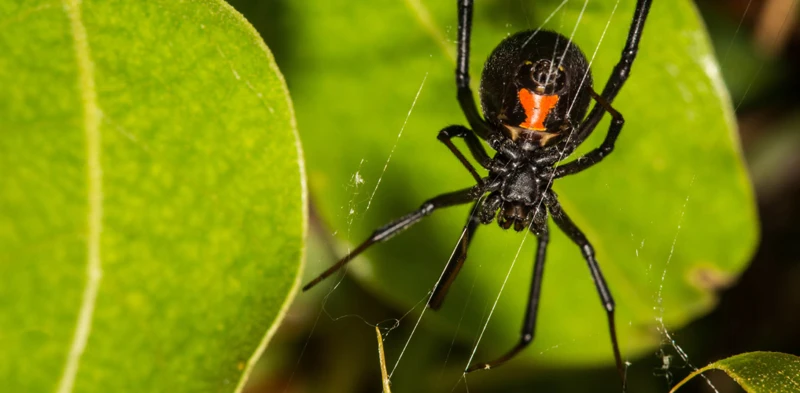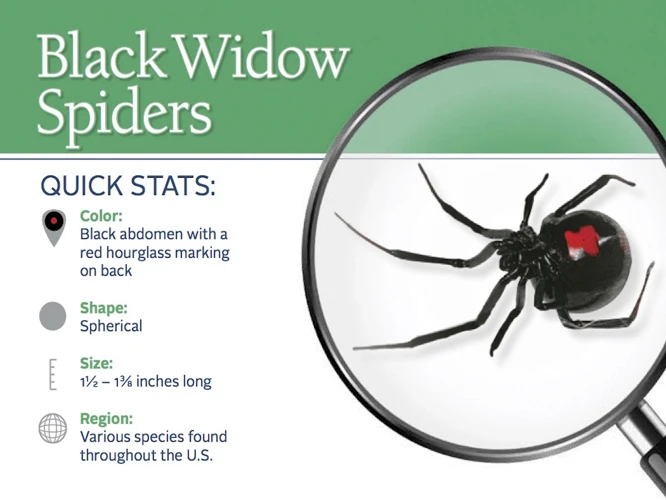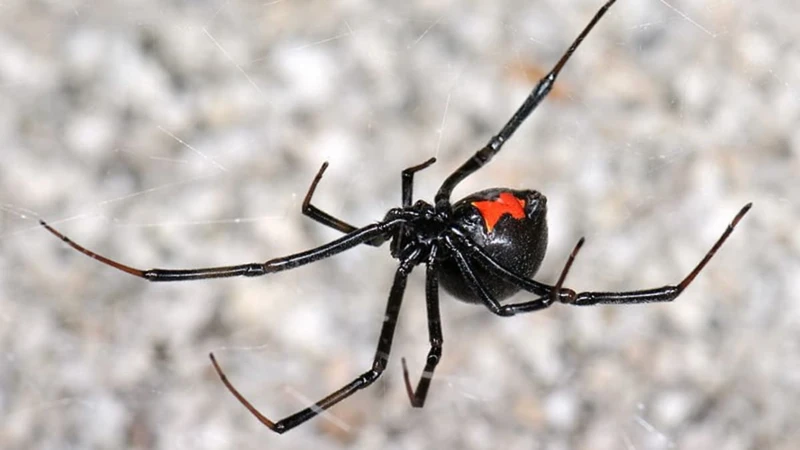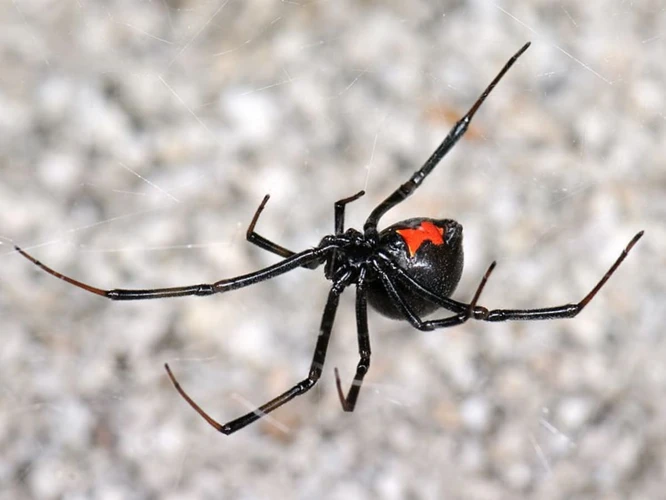Have you ever wondered how long black widow spiders can survive without food? These deadly arachnids, known for their signature hourglass shape and potent venom, are feared by many. While we may hope to keep these spiders far away from us, it’s still important to understand their survival tactics in case of a potential encounter. In this article, we’ll take a closer look at the black widow spider’s diet, environmental and spider factors affecting their survival, and explore their strategies for surviving without food. So grab a seat and let’s unravel the mystery behind these formidable predators.
Black Widow Spider Diet

As fascinating as it is to watch black widow spiders spin their webs, it’s even more intriguing to learn what they eat. These arthropods have a particular diet that includes various insects, and even other black widow spiders. However, have you ever wondered what happens if a black widow spider goes without food for an extended period? In this section, we will delve into the eating habits and the challenges that arise when black widow spiders don’t receive a regular snack. For more information on black widow spider feeding behavior, check out this article.
What Do Black Widow Spiders Eat?
Black widow spiders are known for their deadly venom and striking appearance. However, they are also known for their unique eating habits.
What Do Black Widow Spiders Eat?
Black widow spiders are carnivorous and primarily eat insects. They have been known to eat a variety of insects including flies, mosquitoes, grasshoppers, and even other spiders. However, their favorite prey is thought to be various species of beetles.
In some cases, black widow spiders have been known to eat prey that is much larger than themselves. They are able to inject venom into their prey and then wrap it up in their web, allowing the venom to incapacitate the prey while they feed on it.
It is interesting to note that black widow spider life cycle also plays a part in their diet. Juvenile black widow spiders will eat small insects such as midges and fruit flies. As they grow bigger they will move on to more substantial prey.
Here is an example of some of the prey items that black widow spiders commonly eat:
| Prey Item | Description |
|---|---|
| Beetles | Most common prey item, ranging from small to large species. |
| Flies | Various fly species, including houseflies and horseflies. |
| Moths | Commonly caught during the night when they are attracted to lights. |
| Grasshoppers | Usually only caught by larger black widow spiders. |
It is important to note that black widow spiders are also fearless predators and will sometimes eat larger prey if they are hungry enough. They have also been known to cannibalize other black widow spiders, even males of their own species.
If you want to learn more about the prey items that black widow spiders eat, check out our article on prey items for black widows.
What Happens When Black Widow Spiders Don’t Eat?
When Black Widow Spiders can’t find their food, they begin to deprive of nutrients that are useful for survival. They soon become weak and malnourished which affects their reproductive life and overall health. Without eating, their metabolism slows down, leading to weight loss and decreased muscle mass. Black Widow spiders can become more aggressive and unpredictable when they don’t have enough food. They lose their ability to hunt effectively and their immune system weakens, leaving them vulnerable to diseases. It is essential for black widow spiders to get their nutritional needs met and avoid long periods of starvation.
It’s not uncommon for spiders to go days or even weeks without food, depending on various factors. However, prolonged periods of starvation can lead to severe outcomes, which may eventually prove fatal for the spider. Spiderlings and mature spiders have different survival habits when it comes to lack of food. Younger spiders have a higher metabolic rate and require more frequent feeding. On the other hand, adult black widow spiders can survive for more extended periods without eating due to their slower metabolic rate.
Black Widow Spiders’ feeding habits depend on many factors, including environmental and spider factors. The next section will provide more information on those factors that affect the survival of Black Widow Spiders without food.
Factors Affecting Survival Without Food

Understanding the various factors that affect survival without food is crucial when it comes to Black Widow spiders. These factors influence how long these spiders can go without a meal, which is essential information for anyone interested in the life cycle of Black Widow spiders. Environmental and spider-related factors are the primary determinants to consider in this context. While it may seem like a concerning topic, learning about the different factors that influence the survival of Black Widow spiders can help us appreciate them better. Let’s examine these factors in more detail below. To learn more about the feeding habits of Black Widow spiders, check out this article.
Environmental Factors
Several environmental factors need to be considered when examining the survival of black widow spiders without food. Temperature, humidity, and climate changes are significant factors that can impact the survival of these venomous arachnids.
Temperature: Black widow spiders tend to thrive in warm environments. When the temperature is hot, black widows become more active and their metabolic rate increases. In contrast, when the temperature drops, their metabolism slows down, and they may become sluggish, which means that they require less food to survive.
Humidity: Black widow spiders are known to prefer humid environments. If the surroundings have high humidity levels, they can maintain the liquid balance in their bodies that is necessary for their survival and stay hydrated longer, which means they can go without food for longer periods.
Climate changes: Climate changes could be one of the critical factors that influence the length of time a black widow spider can survive without food. Due to global warming, temperatures are rising, and the climate is changing around the world. This change in climate could make some areas that were previously unsuitable for the growth and reproduction of black widow spiders more hospitable to them. As a result, the spiders could thrive in these areas for longer periods without food.
Black widow spiders are resilient creatures that can survive without food for long periods. However, several factors will significantly affect their survival without food, such as the environmental and individual spider factors that should be considered. If you want to learn more about the feeding habits of black widow spiders, you may find black widow spiders eating habits environments a helpful resource to check.
Spider Factors
When it comes to spider factors affecting survival without food, there are several things to consider. One of the most important is the age and size of the spider. Juvenile spiders have a higher metabolic rate than adults, which means they may not be able to survive as long without food. Adult black widow spiders, on the other hand, have a much lower metabolic rate, which allows them to go longer periods without a meal.
Another factor to consider is the gender of the spider. Male black widows have much shorter lifespans than females and are often consumed by females after mating. This means that males do not need to store as much energy or go as long without food as females. Females, on the other hand, have a much longer lifespan and may need to go several months without food. If you want to learn more about male black widow spiders being eaten, check out our article on male black widows getting eaten.
The temperature can also impact a spider’s survival without food. Spiders are cold-blooded creatures, which means their metabolism is directly tied to the temperature of their environment. A colder environment can slow down a spider’s metabolism, which helps them conserve energy and allows them to go longer without food. However, a warmer environment can speed up a spider’s metabolism, which means they will need to eat more frequently.
The species of spider can also play a role in how long they can go without food. Different species have different adaptations for surviving harsh conditions. Black widows, for example, have the ability to cannibalize their mates or even their own spiderlings to survive. To learn more about black widow spider cannibalism, check out our article on black widow spider cannibalism.
Here is a table summarizing the spider factors that can impact their survival without food:
| Spider Factor | Impact on Survival Without Food |
|---|---|
| Age/Size | Juvenile spiders have higher metabolic rates and may not be able to survive as long without food. Adult spiders have lower metabolic rates and can survive longer without food. |
| Gender | Male black widows have shorter lifespans and do not need to store as much energy or go as long without food as females. Females have longer lifespans and may need to go several months without food. |
| Temperature | Colder environments slow down a spider’s metabolism, which helps them conserve energy and allows them to go longer without food. Warmer environments speed up a spider’s metabolism, which means they will need to eat more frequently. |
| Species | Some spider species have adaptations for surviving harsh conditions, such as cannibalism. |
How Long Can Black Widow Spiders Go Without Food?

Black widow spiders are known for their notorious reputation as venomous predators. They can prey on various insects including mosquitoes, flies or grasshoppers, but they aren’t too picky and will also feed on small mice or lizards. However, there are scenarios in which black widow spiders may have to go without food for some time.
So, how long can Black Widow Spiders go without food?
Black widow spiders are remarkably capable of survival without food, and can go up to several months without it. In fact, some studies suggest that they may survive up to a year without food. The amount of time a black widow spider can survive without food depends on several factors such as the ambient temperature, the spider’s age, size, and sex, and the availability of water.
Temperature plays an essential role in the metabolism and activity of black widow spiders. As the temperature drops, the metabolic rates of spiders slow down, allowing them to conserve more energy when food is not available. In these situations, spiders may enter a state of torpor or hibernation, which helps reduce their energy needs. During the colder months, they may also seek refuge under rocks, bark, or inside homes, where the temperature is more stable.
The size of the spider also affects how long it can go without food. Larger spiders have more significant energy reserves, allowing them to survive for a more extended period without food. Females are also known to have higher energy reserves than males because of their larger bodies.
Lastly, access to water can prolong the survival of black widow spiders without food. These spiders can tolerate dehydration for a short period, but they need water to remain hydrated and maintain their metabolism. Black widow spiders can get water from their food, but they also absorb moisture from the air, which can help them survive for longer without eating.
Conclusion:
Black widow spiders have remarkable abilities to survive without food. They can go up to multiple months without food, depending on several factors such as temperature, size, sex, and access to water. However, it’s essential to remember that feeding provides vital nutrients and energy that spiders need to maintain their health and reproductive success. If their food sources are not available, they may resort to cannibalism or migration to find more favourable feeding grounds.
Survival Strategies of Black Widow Spiders
After discussing the factors that can influence how long black widow spiders can go without food, it’s time to take a closer look at their survival strategies. These eight-legged arachnids have a few tricks up their sleeves when it comes to staying alive during times of scarcity. Let’s explore some of the ways black widow spiders increase their chances of survival without food.
For instance, did you know that black widow spiders can resort to cannibalism when food is scarce? Or that their webbing and mobility play a crucial role in their survival? Let’s dive into these fascinating strategies that these spiders use to survive.
Webbing
Black widow spiders are known for their ability to survive for long periods without any food. One of the strategies they use to preserve their energy during these periods is webbing. Webbing serves several purposes for black widow spiders, including as a mechanism for the spider to conserve energy.
Webbing Helps Black Widow Spiders Conserve Energy
By constructing webs, black widow spiders can catch prey with minimal effort. Instead of actively hunting prey, the spider waits for a meal to get ensnared in their web. This way, the spider only needs to expend the energy necessary to spin webs, as opposed to actively seeking food. Spiders can then use the energy they saved to sustain them for a more extended period without food.
The Different Types of Webs
There are two types of webs that black widow spiders spin: tangle webs and cobwebs. Tangle webs are designed to trap insects that come into contact with them; these webs are non-sticky and function through entanglement. Cobwebs, on the other hand, are irregular and tangled webs that capture prey through their superficially sticky texture. The spider’s webbing behavior depends on several factors, including their habitat, the availability of prey, and the spider’s size.
Webbing and Feeding Habits of Black Widow Spiders
Black widows have a unique feeding habit where they liquefy their prey and then suck out the liquid. Webbing makes it easy for the spider to engulf its prey in silk and then feed on it over a more extended period. By slowly consuming their prey, black widow spiders can maximize their food resources, which helps them survive for longer periods without food.
Webbing plays a crucial role in the survival of black widow spiders when food is scarce. The spider’s ability to preserve its energy through webbing ensures it can survive extended periods without food. To learn more about black widow spiders and how they fit into the food chain, check out our article on the /black-widow-spiders-food-chain/. If you’re interested in learning about the feeding habits of juvenile black widow spiders, head over to our guide on /feeding-habits-juvenile-black-widow-spiders/. Alternatively, you can learn more about the anatomy of black widow spider’s mouth by reading our comprehensive guide on /anatomy-black-widow-mouth/.
Mobility
Black widow spiders have various survival strategies, and one of them is their impressive mobility. These spiders are quick and agile, allowing them to find food and escape predators quickly. Mobility is crucial for black widow spiders when they are searching for food, especially when times are tough, and food sources are scarce.
There are two types of mobility that black widow spiders exhibit: crawling and ballooning. Crawling is a primary mode of locomotion for black widow spiders, and they use it to travel short distances to find food. Ballooning, on the other hand, is used to travel long distances, especially when there is no food around. Ballooning involves the spider releasing a thread of silk that catches the wind and lifts the spider off the ground, allowing it to travel long distances.
Table 1: Comparison of Crawling and Ballooning in Black Widow Spiders
| Mobility Type | Use | Distance Traveled | Speed |
|---|---|---|---|
| Crawling | Short Distance Travel to Find Food | A Few Feet | Slow |
| Ballooning | Long Distance Travel when Food is Scarce | Several Miles | Fast |
Aside from finding food and avoiding predators, the mobility of black widow spiders also helps them find optimal environments for their survival. Their ability to move quickly allows them to locate areas where they can thrive, such as areas that are warm, humid, and have plenty of prey.
The mobility of black widow spiders, both crawling and ballooning, is crucial for their survival, allowing them to find food, escape predators, and locate optimal environments. Their impressive mobility is one of the factors that contribute to their success as a species despite their reputation as a dangerous predator.
Cannibalism
Black widow spiders have one survival strategy that may seem quite shocking to humans: cannibalism. This means that they may eat other spiders, including other black widows. While it may seem strange to us, cannibalism is actually quite common in the animal world – particularly among spiders.
Why Do Black Widow Spiders Engage in Cannibalism?
Cannibalism is a survival strategy for black widow spiders when food becomes scarce. When food is scarce, black widows may resort to eating other spiders to stay alive. In some cases, the female black widow spider may even eat her mate after they have mated to ensure that she has enough food to survive. It may sound brutal, but this behavior is actually quite common among spiders.
How Does Cannibalism Help the Black Widow Spider Survive?
Cannibalism may be a gruesome survival strategy, but it is an effective one for black widows. By eating other spiders, black widows can conserve their energy and survive for longer periods without food. Cannibalism also gives female black widows an advantage in reproducing, as they can gain extra nutrients needed to lay more eggs.
Do All Black Widow Spiders Engage in Cannibalism?
Not all black widow spiders engage in cannibalism. In some cases, black widows will avoid eating members of their own species and will instead opt to eat other types of spiders or insects. However, when food becomes scarce, black widows may resort to eating their own kind in order to survive.
Cannibalism may seem shocking to humans, but it is just another survival strategy for black widow spiders. While it may seem gruesome, cannibalism helps these spiders to conserve their energy and stay alive when food is scarce.
Conclusion
After delving deep into the diet, survival strategies and the factors that affect the survival of Black Widow Spiders without food, it is clear that these arachnids are well-adapted to life even in the harshest conditions. While they may prefer a diet of insects, their ability to go without food for weeks or even months is truly impressive.
Their survival without food is largely determined by environmental factors such as temperature, humidity, and availability of a water source. In addition, spider factors such as age, size, and overall health play a vital role in their ability to go without food.
Interestingly, Black Widow Spiders have a few survival strategies up their sleeves that allow them to survive for extended periods without food. Their webbing, mobility, and cannibalism all work together to ensure their survival in times of scarcity.
It is important to note that while these creatures can go without food for long periods of time, it is still best to avoid keeping them in captivity without access to regular sustenance. This can be detrimental to their health and overall well-being.
Overall, Black Widow Spiders are impressive creatures that have evolved to survive even the harshest of conditions. With their survival strategies and ability to adapt to changing environments, it is no wonder that they have been able to thrive for so long.
Frequently Asked Questions
1. How long can a black widow spider survive without food?
Black widow spiders can survive up to 200 days without food under ideal conditions.
2. What do black widow spiders eat?
Black widow spiders primarily feed on insects like flies, mosquitoes, and grasshoppers.
3. Can black widow spiders go without water as well?
Black widow spiders can get the water they need from their prey and do not require a separate water source.
4. What happens if a black widow spider doesn’t eat for a long time?
If a black widow spider goes without food for an extended period, it will lose weight and become lethargic. Eventually, it will die if it does not find a new food source.
5. How do environmental factors affect the survival of black widow spiders?
Environmental factors like temperature and humidity can have a significant impact on the survival of black widow spiders, as they are sensitive to changes in their surroundings.
6. Can black widow spiders survive in extreme conditions?
Black widow spiders are hardy creatures and can survive in extreme conditions like drought and extreme temperatures by hibernating or becoming dormant.
7. How do black widow spiders catch their prey?
Black widow spiders catch their prey in their webs, using their strong webs and powerful venom to immobilize their victims.
8. Can black widow spiders survive without their webs?
Black widow spiders rely heavily on their webs to catch prey, protect themselves, and regulate their body temperature, so they would likely struggle to survive without them.
9. How important is cannibalism to the survival of black widow spiders?
Cannibalism is a crucial survival strategy for black widow spiders, as it helps them to conserve energy and obtain the nutrients they need to survive.
10. How can you prevent black widow spiders from invading your home?
You can prevent black widow spiders from invading your home by sealing cracks and crevices, clearing clutter, and avoiding overwatering plants and other vegetation around your home.






